 W
WAdansonia digitata, the African baobab, is the most widespread tree species of the genus Adansonia, the baobabs, and is native to the African continent. The long-lived pachycauls are typically found in dry, hot savannahs of sub-Saharan Africa, where they dominate the landscape, and reveal the presence of a watercourse from afar. Their growth rate is determined by ground water or rainfall, and their maximum age, which is subject to much conjecture, seems to be in the order of 1,500 years. They have traditionally been valued as sources of food, water, health remedies or places of shelter and are steeped in legend and superstition. European explorers of old were inclined to carve their names on baobabs, and many are defaced by modern graffiti.
 W
WAdenia globosa is a species of flowering plant in the passionflower family, Passifloraceae. It is native to tropical Africa, where it occurs in Ethiopia, Kenya, Somalia, and Tanzania. It is known as mpaga in Swahili.
 W
WAdenium obesum is a poisonous species of flowering plant belonging to tribe Nerieae of subfamily Apocynoideae of the dogbane family, Apocynaceae, that is native to the Sahel regions, south of the Sahara, and tropical and subtropical eastern and southern Africa and Arabia. Common names include Sabi star, kudu, mock azalea, impala lily and desert rose.
 W
WAerangis luteoalba is a species of epiphytic orchid native to eastern and central Africa. This species includes 2 currently recognized varieties:Aerangis luteoalba var. luteoalba - Uganda, Congo-Brazzaville, Congo-Kinshasa Aerangis luteoalba var. rhodosticta (Kraenzl.) J. Stewart (1979) - Cabinda, Central African Republic, Cameroon, Ethiopia, Kenya, Tanzania, Uganda, Congo-Brazzaville, Congo-Kinshasa
 W
WAframomum corrorima is a species of flowering plant in the ginger family, Zingiberaceae. The spice, known as Ethiopian cardamom, false cardamom, or korarima, is obtained from the plant's seeds, and is extensively used in Ethiopian and Eritrean cuisine. It is an ingredient in berbere, mitmita, awaze, and other spice mixtures, and is also used to flavor coffee. Its flavor is comparable to that of the closely related Elettaria cardamomum or green cardamom. In Ethiopian herbal medicine, the seeds are used as a tonic, carminative, and laxative.
 W
WAfrocarpus gracilior is a species of coniferous tree in the family Podocarpaceae known as benet in Marakwet and East African yellowwood, African fern tree, or bastard yellowwood in English
 W
WAloe secundiflora is an aloe widespread in open grassland and bushland in Ethiopia, Sudan, Kenya, and Tanzania.
 W
WAmorphophallus abyssinicus, also known as Bagana (Sidamo), is a plant of the genus Amorphophallus. It is native to southern Ethiopia, where it is grown in gardens, hence its specific epithet, abyssinicus, derived from Latin and meaning "Abyssinian" or "Ethiopian".
 W
WBaphia abyssinica is a species of legume in the family Fabaceae. It is found in Ethiopia and Sudan. It is threatened by habitat loss.
 W
WBerchemia discolor, known as "bird plum" or "brown ivory" in English, is a tree native to southern and eastern Africa including Madagascar. It is a broadleaf tree growing to 18 m (60 ft).
 W
WBoscia senegalensis, commonly known as hanza, is a member of the family Capparaceae.
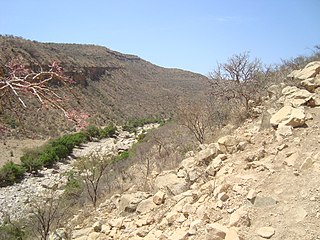 W
WBoswellia papyrifera, also known as Sudanese frankincense, is a species of flowering plant and frankincense that is native to Ethiopia, Eritrea and Sudan. The tree is cultivated in Ethiopia because of its valuable resin. The incense smoke is characterized by a fresh lemon-pine scent, and is therefore highly esteemed. In Ethiopia where it is called itan zaf, it comes in semi-translucent yellow tears. The gum resin of Boswellia papyrifera coming from Ethiopia, Sudan and E. Africa is believed to be the main source of frankincense of antiquity.
 W
WBothriochloa bladhii is a Neotropic grass in the family Poaceae, found primarily in tropical Africa, and tropical and temperate Asia, and Australia. The type specimen was collected from China by Finnish botanist Peter Johan Bladh. The name of Bladh is honored in the specific epithet.
 W
WBrassica carinata is a species of flowering plant in the Brassicaceae family. It is referred to by the common names Ethiopian rape, Ethiopian mustard, and Abyssinian mustard. It is believed to be a hybrid between Brassica nigra and Brassica oleracea.
 W
WBrassica nigra, or black mustard, is an annual plant cultivated for its black or dark brown seeds, which are commonly used as a spice. It is native to tropical regions of North Africa, temperate regions of Europe, and parts of Asia.
 W
WBreonadia is a monotypic genus of flowering plants in the family Rubiaceae. It was described by Colin Ernest Ridsdale in 1975. The genus contains only one species, viz. Breonadia salicina, which is found in tropical and southern Africa from Mali and Benin east to Ethiopia, south to South Africa, as well as Yemen, Saudi Arabia and Madagascar.
 W
WCarex monostachya is a species of sedge native to the mountains of East Africa.
 W
WCombretum hereroense, commonly known as the russet bushwillow and the mouse-eared combretum, is a deciduous shrub or small tree that is found from eastern Africa to northern South Africa. Over its extensive range it is variable with respect to leaf shape, fruit size and indumentum.
 W
WCommiphora myrrha, called myrrh, African myrrh, herabol myrrh, Somali myrrhor, common myrrh, or gum myrrh is a tree in the Burseraceae family. It is one of the primary trees used in the production of myrrh, a resin made from dried tree sap. The tree is native to the Arabian peninsula and to Africa. It is called 'mur' (المر) in Arabic, meaning bitter. It is the gum of the myrrh tree. Its oil is called oleoresin. It famously comes from Mecca, so it is called 'Mur Makki'.
 W
WCordeauxia edulis is a plant in the family Fabaceae and the sole species in the genus Cordeauxia. Known by the common name yeheb bush, it is one of the economically most important wild plant at the Horn of Africa, but it is little known outside of its distribution area. It is a multipurpose plant, which allows the survival of nomads by providing them with seeds. Further the bush serves forage for livestock, firewood and dye. Its wild population is currently declining. Because it is potentially valuable for other hot, dry regions as a resource for food and fodder, it's recommended to take measures against its extinction.
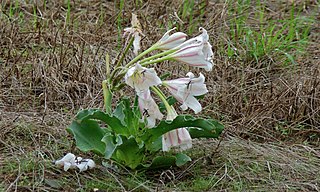 W
WCrinum macowanii is a species of flowering plant in the Amaryllidaceae family. It is a deciduous bulbous plant species native to Africa that has been used in traditional medicine throughout southern Africa.
 W
WCucumis dipsaceus, also known as Arabian cucumber or hedgehog cucumber, is an annual climbing herb that can be found in tropical and arid locations. The plant is native to eastern Africa, first found in Sudan, southern Egypt, and Ethiopia. The developed fruits of the plant change from green to yellow and contain many seeds. The hairs that cover the oblong fruits nickname this species the “hedgehog cucumber”.
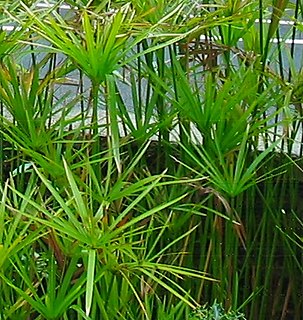 W
WCyperus alternifolius, with the common names of umbrella papyrus, umbrella sedge or umbrella palm, is a grass-like plant in the very large genus Cyperus of the sedge family, Cyperaceae.
 W
WDietes iridioides, commonly named African iris, fortnight lily, and morea iris, is a species of plant in the family Iridaceae that is native to Southern Africa.
 W
WDiplotaxis muralis, the annual wall-rocket, is a species of flowering plant in the family Brassicaceae. This plant is native to Europe, Asia, and Africa, but it is found throughout the temperate world, where it has naturalized. This is an erect mustard-like plant rarely reaching half a meter in height. It has lobed leaves and its stems are topped with dense inflorescences of yellow, or occasionally light purple, flowers with small oval petals and large anthers. The fruit is a podlike silique two to four centimeters long.
 W
WDracaena fragrans, is a flowering plant species that is native throughout tropical Africa, from Sudan south to Mozambique, west to Côte d'Ivoire and southwest to Angola, growing in upland regions at 600–2,250 m (1,970–7,380 ft) altitude.
 W
WEhretia cymosa is a small tree belonging to the Boraginaceae or borage family. It occurs over a wide range of habitat throughout of western, central and eastern Africa, including Benin, Côte d'Ivoire, Cameroon, Ethiopia, Kenya, Comoros, Madagascar, Mascarenes, Zimbabwe and Mozambique.
 W
WErica arborea, the tree heath or tree heather, is a species of flowering plant (angiosperms) in the heather family Ericaceae, native to the Mediterranean and North Africa. It is also cultivated as an ornamental.
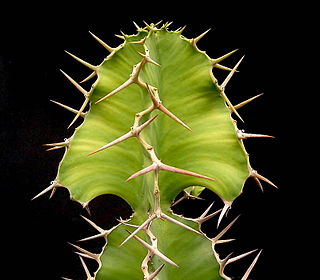 W
WEuphorbia breviarticulata is a species of plant in the family Euphorbiaceae. It is endemic to Ethiopia, Tanzania, Kenya, Somalia, Sudan, and Uganda.
 W
WEuphorbia candelabrum is a succulent species of plant in the family Euphorbiaceae, one of several plants commonly known as candelabra tree. It is closely related to 3 other species of Euphorbia in particular; Euphorbia ingens in the dry regions of South Africa, Euphorbia conspicua from western Angola, and Euphorbia abyssinica which is native to a number of countries including Sudan, Eritrea, Djibouti, Ethiopia and Somalia.
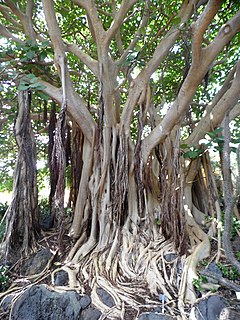 W
WFicus vasta is a fig plant found in Ethiopia and Yemen. The tree is a species of sycamore-fig.
 W
WGladiolus murielae is a species of flowering plant in the family Iridaceae, native to eastern Africa, from Ethiopia to Malawi. It has been given a number of English names, including Abyssinian gladiolus and fragrant gladiolus. It was formerly placed in the genus Acidanthera.
 W
WGuizotia abyssinica is an erect, stout, branched annual herb, grown for its edible oil and seed. Its cultivation originated in the Eritrean and Ethiopian highlands, and has spread to other parts of Ethiopia. Common names include noog/nug ; niger, nyger, nyjer, or niger seed ; ramtil or ramtilla; inga seed; and blackseed.
 W
WHagenia is a monotypic genus of flowering plant with the sole species Hagenia abyssinica, native to the high-elevation Afromontane regions of central and eastern Africa. It also has a disjunct distribution in the high mountains of East Africa from Sudan and Ethiopia in the north, through Kenya, Uganda, Rwanda, Burundi, Democratic Republic of Congo, and Tanzania, to Malawi and Zambia in the south.
 W
WHyphaene coriacea, the Lala palm, is a species of palm tree native to the eastern Afrotropics. It occurs in eastern Africa from Somalia to Kwazulu-Natal, South Africa, and is also found in the coastal flats of Madagascar and on Juan de Nova Island in the Mozambique Channel Islands.
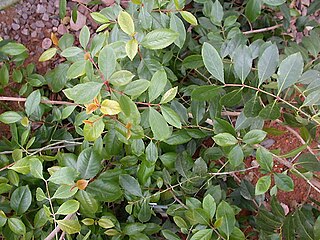 W
WKhat or qat is a flowering plant native to Ethiopia. Khat contains the alkaloid cathinone, a stimulant, which is said to cause excitement, loss of appetite, and euphoria. Among communities from the areas where the plant is native, khat chewing has a history as a social custom dating back thousands of years analogous to the use of coca leaves in South America and betel nut in Asia.
 W
WOchrocephala is a genus of Ethiopian flowering plants in the thistle tribe within the daisy family.Species
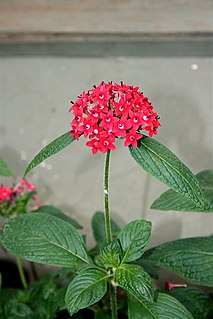 W
WPentas lanceolata, commonly known as Egyptian starcluster, is a species of flowering plant in the madder family, Rubiaceae that is native to much of Africa as well as Yemen. It is known for its wide use as a garden plant where it often accompanies butterfly gardens.
 W
WPhytolacca dodecandra, commonly known as endod, gopo berry, or African soapberry, is a trailing shrub or climber native to Tropical Africa, Southern Africa, and Madagascar.
 W
WPlicosepalus sagittifolius is a woody, photosynthesising, parasitic plant species that grows on the branches of mostly Acacia-species, by means of tapping roots. It has glaucus, leathery, entire, 1–6 cm long leaves set oppositely along the stem, with umbels of initially long up-curved pale greenish-yellow buds, that open explosively, the petals usually bright yellow, strongly curling, long stamens and style clear red, orange or pink, and quickly falling after fertilisation. The initially green oval berries color red when ripe. The species is assigned to the showy mistletoe family. In the Afar language it is called hatote, while the vernacular name in the Oromo language is dertu dedacha.
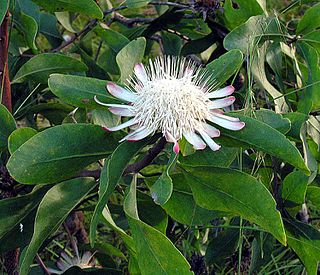 W
WProtea gaguedi is a species of tree which belongs to the genus Protea.
 W
WProtea madiensis, commonly known as the tall woodland sugarbush, is a flowering shrub which belongs to the genus Protea. It is native to the montane grasslands of Sub-Saharan Africa.
 W
WRorippa palustris, marsh yellow cress, is a species of flowering plant in the family Brassicaceae. It is widespread and native to parts of Africa, and much of Asia, Europe and Eurasia, North America and the Caribbean. It can also be found in other parts of the world as an introduced species and a common weed, for example, in Australia and South America. It is an adaptable plant which grows in many types of damp, wet, and aquatic habitat. It may be an annual, biennial, or perennial plant, and is variable in appearance as well.
 W
WRosa abyssinica is a rose native to sub-Saharan Africa. Non-Africans first learned of the rose in the writings of 19th-century Scottish botanist Robert Brown. Rosa abyssinica is included in the genus Rosa, and the family Rosaceae. No subspecies are listed in the Catalogue of Life.
 W
WScadoxus puniceus, commonly known as the paintbrush lily, is a species of bulbous plant. It is native to much of southern and eastern Africa: Ethiopia, Sudan, Tanzania, Malawi, Mozambique, Zambia, Zimbabwe, Botswana, Eswatini (Swaziland), and South Africa. Scadoxus puniceus can be found in cool, shady habitat such as ravines and forests, where it is often found in moist leaf litter. Other common names include snake lily, royal paintbrush, King-of-Candida, African blood lily (English), rooikwas (Afrikaans), isisphompho, and umgola (Zulu). There are nine species of Scadoxus of which three, S. puniceus, S. multiflorus and S.membranaceus, occur in South Africa.
 W
WSolanum incanum is a species of nightshade that is native to Sub-Saharan Africa and the Middle East, eastwards to India. Common names include thorn apple, bitter apple, bitterball and bitter tomato It may be confused with the similar S. linnaeanum where their ranges overlap in Africa. In ancient India, Solanum incanum was domesticated into the eggplant, Solanum melongena. In biblical literature, it is sometimes used as a "hedge of thorns".
 W
WSolanum nigrum, the European black nightshade or simply black nightshade or blackberry nightshade, is a species of flowering plant in the genus Solanum, native to Eurasia and introduced in the Americas, Australasia, and South Africa. Ripe berries and cooked leaves of edible strains are used as food in some locales, and plant parts are used as a traditional medicine. A tendency exists in literature to incorrectly refer to many of the other "black nightshade" species as "Solanum nigrum".
 W
WSpathodea is a monotypic genus in the flowering plant family Bignoniaceae. The single species it contains, Spathodea campanulata, is commonly known as the African tulip tree. The tree grows between 7–25 m (23–82 ft) tall and is native to tropical dry forests of Africa. It has been nominated as among 100 of the "World's Worst" invaders.
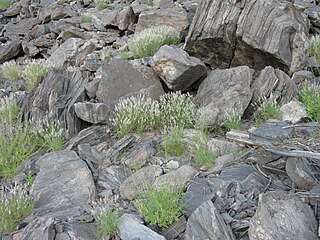 W
WStipagrostis obtusa is a perennial grass belonging to the grass family (Poaceae). It is a widespread species, being native to North Africa, Mauritania, Chad, Ethiopia, Southern Africa, Western Asia, the Arabian Peninsula and Pakistan.
 W
WThunbergia natalensis is a species of flowering plant in the family Acanthaceae, that is native to parts of mainland Africa, including South Africa, Eswatini, Tanzania, Ethiopia, Malawi and Zimbabwe. It occurs in forest margins, bush and grassland. Normally evergreen, it responds to dry or cold winters by losing its leaves and going dormant. Common names include dwarf thunbergia, Natal blue thunbergia and Natal blue-bell.
 W
WUtricularia arenaria is a small annual carnivorous plant that belongs to the genus Utricularia. It is native to tropical and southern Africa, where it can be found in Angola, Burundi, Cameroon, Côte d'Ivoire, the Democratic Republic of the Congo, Ethiopia, Gabon, Ghana, Kenya, Madagascar, Malawi, Mali, Mozambique, Nigeria, Senegal, Sierra Leone, South Africa, Sudan, Tanzania, Togo, Uganda, Zambia, and Zimbabwe. There has also been a single collection from central India in Madhya Pradesh. U. arenaria grows as a terrestrial plant in damp, sandy or peaty soils in swampy grasslands or marshes at altitudes from near sea level to 2,400 m (7,874 ft). It was originally described and published by Alphonse Pyrame de Candolle in 1844.
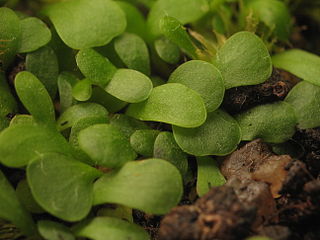 W
WUtricularia livida, the leaden bladderwort, is a species of flowering plant in the bladderwort family, native to central and southern Africa, and Mexico. Growing to 50 cm (20 in) tall and broad, it is a carnivorous perennial. It was originally described and published by Ernst Heinrich Friedrich Meyer in 1837.
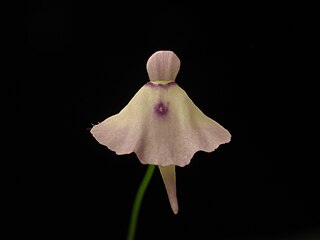 W
WUtricularia pubescens is a small to medium-sized, probably annual, terrestrial or lithophytic carnivorous plant that belongs to the genus Utricularia and is the only member of Utricularia sect. Lloydia. U. pubescens is native to India, tropical Africa, and Central and South America. It was originally published and described by James Edward Smith in 1819 and placed in its own section, Lloydia, by Peter Taylor in 1986. It grows as a terrestrial or lithophytic plant in boggy grasslands in damp peaty soils at altitudes from sea level to 1,900 m (6,234 ft). This species possesses small peltate leaves, which are diagnostic for this species in the genus.
 W
WUtricularia scandens is a small, probably annual carnivorous plant that belongs to the genus Utricularia. It has a wide native distribution that includes Africa and Asia. U. scandens grows as a terrestrial plant in wet grasslands and bogs at lower altitudes around sea level up to 2,300 m (7,546 ft). It was originally described by Ludwig Benjamin in 1847. There is a significant amount of synonymy established for this species, in part because of its large distribution and variable morphology.
 W
WUtricularia striatula is a small carnivorous plant that belongs to the genus Utricularia. It is widespread from tropical Africa to New Guinea. U. striatula grows as a lithophyte or epiphyte on wet rocks or tree trunks at altitudes from near sea level to 3,300 m (10,827 ft). It was originally described by James Edward Smith in 1819.
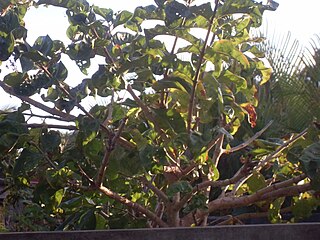 W
WVangueria madagascariensis, commonly known by the names Spanish-tamarind, tamarind-of-the-Indies, or voa vanga, is a species of flowering plant in the family Rubiaceae native to the African continent having edible fruit. It is the type species of the genus Vangueria and was described in 1791 by Johann Friedrich Gmelin.
 W
WVanilla roscheri is a species of flowering plant in the family Orchidaceae found in Kenya, Somalia, Mozambique, Tanzania, Ethiopia, and South Africa.